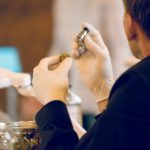
Most adults choose to smoke either a light indica or high CBD hybrid for the relief and avoidance of epileptic shock.
High THC indica strains and most sativa strains should be avoided by epileptics as they can trigger epileptic shock in some individuals.
Smoking is the form of consumption that has the most immediate effect and this is the primary reason why epileptic adults mostly prefer this form of ingestion, as the onset epileptic shocks are often unpredictable and for many people a few inhalations are often enough to deter the episode. For many epileptics, a joint is their equivalent of an epipen.
Mild indica strains containing average amounts of THC (14-19%) and CBD (1-2%) are very common and are particularly well suited for most adults who face epilepsy.
Some epileptics may react particularly well to smoking strains bred to contain higher than normal CBD (above 2%), but there is a limit to the usefulness of high CBD strains when it comes to adult epilepsy as too much CBD without enough THC can cause epileptic shock.
Anything higher than a 1:1 ratio edible, particularly when used over a prolonged period of time, may cause seizures rather than help prevent them. This is why hemp extract (typically containing a ratio of between 30-20/1 [CBD to THC]) is not appropriate for most adult epileptics.
Oils/tinctures/edibles are most effective at helping epileptic adults only when CBD accompanied by higher ratios of THC. Most CBD “specialists” are simply wrong when it comes to this point; Prolonged use of oils with high ratios of CBD can deteriorate an adult epileptics condition rather than improving it. CBD should be present in ratios no greater than 1:1 when being consumed orally by adult epileptics and even then this is not considered the ideal medicine.
Adult epileptics who wish to use cannabis edibles as a remedy for their symptoms should consider trying edibles containing THC-A, as these are safer and more effective than CBD edibles.
THC-A does not typically cause psychotropic effects and can reduce the incidence of seizures in patients young and old. THC-A oils/tinctures/edibles are probably the most common and safest choice for most adult epileptics, while in the case of children this treatment is only recommended for those with resistant forms of epilepsy that are not responding to CBD treatment.
It is also worth mentioning that many using edibles as a primary form of medication for epilepsy also choose to carry around an appropriate strain in the form of a marijuana cigarette as an emergency measure. Once again, the epipen analogy comes to mind.
Different age groups and types of epilepsy often require different types of edible cannabis oil in order to achieve improvements. Standard “child grade” cannabis oil is often made from hemp varieties that contain near trace amounts of THC. This will result in a natural concentration of about 30:1 (CBD to THC) with a contents of 300-650 mg, depending on the genetic type of the raw material. This ratio is believed the safest and most effective for most young children and babies, whereas adult epileptics should not consume a product with such a high ratio of CBD as this could potentially bring on an epileptic shock. Ratios ranging from 1:2 (CBD to THC) all the way to 1:30 seem to be most effective for adults and young adults who wish to consume oil, tincture or other edibles instead of or as adjunct to smoking, whereas prepubescent children find their ideal ratios between 32:1 and 5:1. Edible THCA also seems to be an excellent tool for combating adult epilepsy as well as in some cases of resistant epilepsy in children. The changes in hormonal patterns that causes the body to require an adjustment in ratios tends to happen very quickly as children enter the early stages of puberty, with frequency of epileptic shock increasing as the “child grade” oil ceases to have the effect it once did. At this point the child’s parents will usually choose to gradually raise the ratio of THC until optimum results are obtained, with this ratio usually ending up somewhere between 20:1 and 1:1.
Helpful hint for parents: Rub oil on the inside of the cheek technique; gets assimilated through the membrane in the mouth rather than through the liver, much quicker and better uptake. If child does not react well, try putting the oil in one of the child’s favorite foods. Initial dosages should be no higher than 0.1mg per pound of body weight, raising at a rate no quicker than 0.1mg per pound of body weight per week, until a maximum dosage of 1-2mg per pound of body weight is consumed per day in two to three small doses. ***Remember that young children with resistant forms of epilepsy can require ratios as high as 5:1 ratios (CBD to THC) in order to achieve improvements. Remember to start low and go slow before reaching higher ratios/concentrations, as it is not desirable for young children to consume THC and it is only to be used as a last resort. CBD therapy tends to have a cumulative effect meaning that sometimes it is necessary to keep a dosage level or ratio of oil for several weeks in order to determine whether or not it is effective. ***
All epileptics, as well as anyone else who is new to using cannabis oil products should consume any more than a drop half the size of grain of rice two or three times a day (as needed). This should equal about 0.1-0.2 mg of active ingredient (either THC or CBD) per pound of body weight. After being at this level for 5 to 7 days and ensuring no adverse side effects are observed, patients often choose to increase their dose very gradually at a right no higher than 0.5 mg of active ingredient per pound of bodyweight per week until they find their ideal dosage range, which for most epileptics, tends to be between 1 to 2 mg of active ingredient per pound of bodyweight per day. This means that after raising their tolerance very gradually (as described), epileptics can often comfortably consume around 0.5 mg per pound of body weight per sitting, two or three times a day.
When using edible cannabis, it seems most epileptics obtain the highest levels of relief by keeping a high saturation rate of cannabinoid medicine in the body throughout the day (which is quite costly in the long run), whereas smoking cannabis is much more efficient, as this technique derails an epileptic shock before or as it is happening by smoking just half a joint or less (which will typically equal consuming about 5-10 mg of active ingredient). For this reason, many young adults choose to switch to smoking entirely, or some choose to supplement their regiment of edible oil or tincture with this additional form of therapy if they can afford to. However it is worth saying that childhood epilepsy tends to be much more severe than adult epilepsy and many children suffering from multiple shocks in a short period of time need edible medicine either in an oil format or in a tincture format, using the methods and products described above. This information anecdotal based and is provided to allow epileptics and parents of epileptic children to make their own choices in trying to find the ideal form of treatment for their case.
Disclaimer: The above contains anecdotal information gathered while providing dignified and appropriate access to cannabis throughout the course of many years. The above information has not been scientifically verified and should be used with caution and at your own risk.
MORE FROM THE BLOG





WAIVER & RELEASE (the “Release”)
This event is conducted by CannaReps Consulting Ltd. (“CannaReps or Company”). Please read and submit below.
I am an attendee at an event hosted by CannaReps (the “Workshop“). I release CannaReps from any and all liability, claims, demands, actions and causes of action whatsoever arising out of or related to any loss, damage or injury, including death, that may be sustained by me while participating in the Workshop.
I understand and agree that:
CONFIDENTIALITY
Any confidential or proprietary information or material relating to the Company’s operations or business which I obtain from the Company or its officers, employees, agents, suppliers or customers or otherwise by virtue of my participation with the Company or by the Company’s predecessor. Confidential or proprietary information or material includes, without limitation, the following types of information or material, both existing and contemplated, regarding the Company or its parent, affiliated or subsidiary companies: corporate information, including contractual licensing arrangements, plans, strategies, tactic, policies, resolutions, patents, trademarks, printed or digitized materials, handouts and brochures. Including any marketing information including sales, investment and product plans, customer lists, strategies, methods, customers, prospects and market research data. Including trade secrets; technical information, including drawings, designs, personal information (the “Confidential Information”).
I understand that the copyright and proprietary interest of any material provided to me belongs to CannaReps. All shared experiences from the Workshop are to remain confidential and private. I agree not to disclose any of the information learned during the Workshop outside of the Workshop except with others who attend the Workshop. I will not use any audio or video recording equipment during the Workshop, unless CannaReps approves of the recording and filming by providing prior written consent. I understand that any audio or video recording made during the Workshop is the property of CannaReps. I will not use CannaReps’ information for business or commercial purposes, without first obtaining the prior written consent of CannaReps.
INTELLECTUAL PROPERTY
I understand, acknowledge and agree that all copyright, trademarks, trade secrets, intellectual property rights, and any other rights arising from any designs, and all of the work products and materials conceived, developed or created by the CannaReps and any rights ancillary thereto (collectively, “Intellectual Property Rights”) which were solely or jointly with others, conceives, designs, creates, derives, develops or makes in the course of or in connection with the work with CannaReps shall belong solely to CannaReps. If you haven’t already, you shall promptly disclose to CannaReps in writing any and all Intellectual Property Rights, conceived, created, derived, developed or made in the course of or otherwise in connection with my participation with CannaReps, whether alone or with others, and whether during work shop hours or through the use of facilities and properties of CannaReps.
INDEMNITY
I agrees to indemnify and hold harmless CannaReps, its officers and directors, employees and its affiliates and their respective successors and assigns and each other person, if any, who controls any thereof, against any loss, liability, claim, damage and expense whatsoever (including, but not limited to, any and all expenses whatsoever reasonably incurred in investigating, preparing or defending against any litigation commenced or threatened or any claim whatsoever) arising out of or based upon any false representation or warranty or breach or failure by me to comply with any covenant or agreement made by me herein or in any other document furnished by me to any of the foregoing in connection with this transaction.
CONSENT
Notwithstanding the immediately preceding paragraph, I consent to and grant CannaReps, the Workshop, and its assignees, the right to photograph and record me, my name, voice, appearance and likeness and other material furnished by me for use on trusted online media which include, but are not limited to, their website and social media pages. My hereby release said matter in perpetuity to CannaReps without prejudice and acknowledge that this consent is freely given without expecting compensation.
By submitting my email address below, I agree to receive electronic communication from CannaReps including personal course information, news, updates and promotions regarding CannaReps’ products. I understand that I can withdraw my consent at any time.
PRIVACY POLICY
Protecting your privacy is important to CannaReps. This Privacy Policy (“Privacy Policy”) set outs the ways in which we use your information and how we ensure its protection.
CannaReps will only collect personal information (“Information”) that will allow us to provide, enhance, market or improve our events and services. Information is collected by means of registration for any CannaReps sponsored event or service. Information collected may include name, age, gender, address, email address, payment information, and geographical information.
CannaReps may share Information. CannaReps retains the right to share Information and other statistics with our partners, prospective advertisers, and other third parties for the purposes of improving, protecting, enhancing, and promoting our events and services. CannaReps may also disclose information to our affiliates, agents, contractors, and service providers in order to facilitate the functioning and maintenance of our events and services. We will not sell any information to advertisers or other third parties.
This Privacy Policy only covers the treatment of Information and other non-identifiable information gathered by CannaReps. This Privacy Policy does not apply to the practices of any third-party services. CannaReps does not take responsibility for the content or privacy policies of any third parties. CannaReps recommends that you review the privacy policies of any third-party service providers or events you access, use, or register for through our events or services.
This Privacy Policy has been established to help you understand our commitment to protecting your privacy. CannaReps reserves the right, at any time, to change or replace any portion of our Privacy Policy. You will be notified of any changes, if we believe, they materially impact your experience at our events or services. Continued use of our services after any change to the Private Policy constitutes an acceptance of those changes.
By submitting this Release and providing Information during the registration process, including the Exhibitor’s Agreement, you consent to the collection and use of your Information for these purposes.
If you have any questions or concerns please email us at info@cannareps.ca.